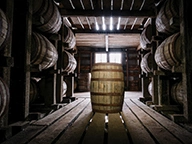Why Oak?
Oak contains a number of compounds that contribute as much as 70% of the final flavour found in a glass of whiskey. This can be attributed to several factors, including chemical compounds that infuse character and flavour into the spirit. The most common elements are:
-
-
- Lignin - Lignin helps promote oxidation and prevents leakage and loss through the wood pores, in addition to adding desirable flavours
- Lipids - Fats and waxes will contribute mouthfeel, texture and viscosity to the final spirit
- Hemicellulose - This contributes natural sugars to the whiskey and added texture to the mouthfeel
- Tannins - American oak commonly contains very low tannins which will contribute astringency, acid and bitterness to the final spirit. The levels of tannins present are reduced as the staves that will later be made into casks cure
- The casks used to mature bourbon are generally subjected to a higher level of charring than some other spirits. The heat treatment that barrels undergo is dependent on the distiller. With a level of charring scale contributing flavours as soft as vanilla, caramel and fruitcake, all the way to heavier flavours like dark spice, ginger and liquorice. Charring levels can be broken down to the following scale:
-
L1 > 15 secs
L2 > 30-35 secs
L3 > 45 secs
L4 > 55 secs

